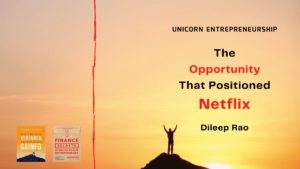
Reed Hastings started Netflix, with Marc Randolph, in 1997 and took the company public in 2002. Netflix was initially financed by Hastings and later by VCs. Paul Holland of Foundation VC notes that Netflix made more money for them than the firm’s 199 other investments combined.
NOTE: One unicorn pays for a lot of VC mistakes. Getting VC is not winning. Remember the 199 non-unicorns in Foundation’s portfolio (for more on VC odds, see The Truth About VC).
3 Tactics to Find the Unicorn Opportunity
- Start with the unmet need. Netflix started by renting movie DVDs by mail using a mail subscription model, compared with Blockbuster’s model of renting DVDs in stores, and charging late fees. Hastings was convinced that the biggest unmet need for the consumer was to avoid late fees. Hastings is said to have hit upon the idea for Netflix after he had to pay a late fee. But entrepreneurs often embellish how they got the original idea. According to co-founder Marc Randolph, the above story is not true. Blockbuster could have imitated this model, but perhaps it was too addicted to the late fees for its profits and failed to adapt. And it had a higher fixed cost of operations due to its retail stores and did not want to lose the extra margins.
- Imitate and improve for more bang per buck. Hastings realized that his gym allowed him to work out as much (or little) as he wanted for one monthly fee. He imitated the gym’s fee model for Netflix – with no due dates and no late fees.
- Jump on an emerging, high-potential trend for take-off. By avoiding late fees, Netflix got a foothold with the emerging trends of DVDs, which were easier to mail than cassettes, and the Internet, which allowed the company to offer its DVDs without the need for a catalog. But Netflix really took off when streaming started on the Internet about 8 years after Netflix was started and movies could be downloaded.
Lesson: Find your unicorn opportunity on an emerging trend where the incumbent giants cannot easily imitate and squash you. Then find the right strategy to take advantage of the edge offered by the opportunity and the trend.




